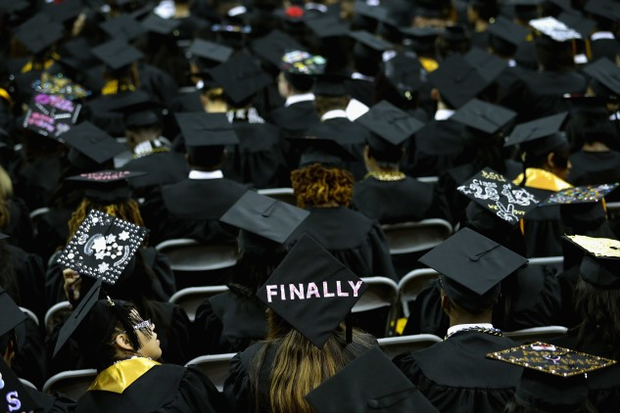Student-Loan Outlook Is Reversed, Showing $31 Billion U.S. Cost
- CBO forecasts burden on taxpayers over next decade
- More borrowers enrolling in income-based repayment plans
Student loans, already a hardship for many young borrowers, now are projected to be a burden for another class of people: U.S. taxpayers.
The federal student loan program will cost the federal government $31 billion over the next decade, according to recent estimatesfrom the nonpartisan Congressional Budget Office. That’s a shift from past CBO forecasts that the government would profit from the program.
“The notion that the student loan portfolio generates huge profits for the federal government is false,” said Kenneth Megan, a senior policy analyst at the Bipartisan Policy Center. “If anything, they’re small and declining.”
Chip Somodevilla/Getty Images
The Congressional Budget Office has estimated the federal student loan program will cost the government about $31 billion over the next 10 years.
The CBO in April 2018 projected the program would bring in $8.7 billion over the next decade. In 2017, the office estimated a $114 billion windfall within the next 10 years.
Politicians on both sides of the aisle, including Sen. Elizabeth Warren (D-Mass.) and President Donald Trump, have criticized the prospect that the government would make money from student loans.
Income-Driven Repayments
The latest data shows how the Education Department’s student loan program has slowly grown more expensive for taxpayers. While some of the increase can be attributed to interest rates, the bulk of the change has come from the cost of the almost $1.5 trillion in federal loans students already have outstanding.
More loans are in default, and less is being collected on outstanding loans, according to the the department’s budget request. In addition, more borrowers than anticipated are enrolling in income-driven repayment plans. These allow borrowers to pay a percentage of their income for a set number of years, after which the remainder of the loan is forgiven.
About 30 percent of borrowers with direct federal loans, the most common type, were in income-driven repayment programs in fiscal 2018, a 29 percent increase from two years before, according to the Education Department.
The additional cost isn’t coming from new loans but current ones, said Gordon Gray, director of fiscal policy with the conservative American Action Forum.
“It’s not like since the last baseline they said ‘Oh my goodness, loans being made now are getting worse,’” Gray said. “Rather, loans that were previously made have gotten more expensive than we thought they would be.”
To contact the reporter on this story: Emily Wilkins in Washington at ewilkins@bgov.com
To contact the editors responsible for this story: Paul Hendrie at phendrie@bgov.com; Robin Meszoly at rmeszoly@bgov.com; Jonathan Nicholson at jnicholson@bgov.com
